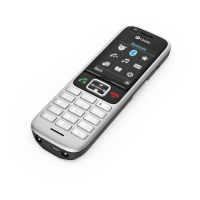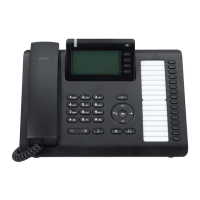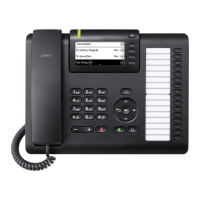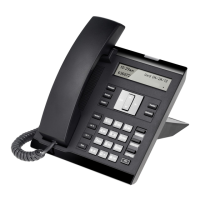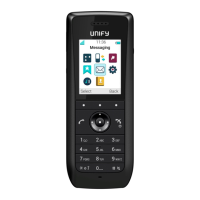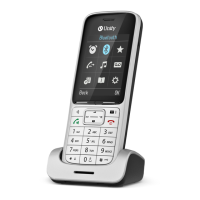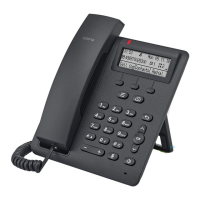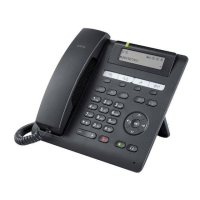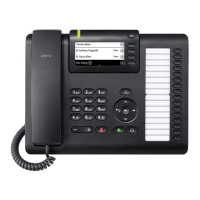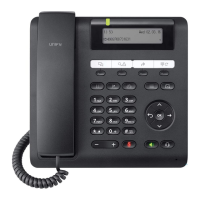Do you have a question about the Unify OpenScape DECT Phone S6 Base and is the answer not in the manual?
| Type | DECT Base Station |
|---|---|
| Protocols | DECT |
| Frequency Band | 1880-1900 MHz |
| Range | Up to 300 meters outdoors, up to 50 meters indoors |
| Network interface | 10/100Base-T Ethernet |
Detailed description of the handset's buttons and features for operation.
Operation of the registration/paging key for locating and registering handsets.
Explanation of warning symbols and their significance in the user guide.
Overview of handset keys and their corresponding functions.
Step-by-step instructions for common telephone operations and settings.
Important safety information regarding device usage, battery handling, and environment.
List of all items included in the telephone package.
Instructions for setting up the telephone base station.
Steps for connecting the charging cradle and setting up the handset.
Detailed instructions on how to connect the charging cradle to power.
Instructions on removing protective film and inserting batteries.
Guidance on correctly inserting batteries into the handset.
Information on how to charge the handset batteries before first use.
Procedure for selecting and changing the display language on the handset.
Instructions for setting the date and time for accurate call logging and alarms.
Steps to set the date and time, including saving the settings.
Instructions for attaching and removing the handset belt clip.
How to attach the professional belt clip and hook the handset into it.
Steps to connect a headset via the 3.5mm jack or Bluetooth.
Guide for connecting the USB data cable for data exchange with a PC.
How to turn the telephone handset on and off.
Instructions for locking and unlocking the handset keypad to prevent accidental use.
Explanation of the control key's functions for navigation and selection.
How to adjust volume levels for receiver, ringtone, and handsfree modes.
Details on assigning and using the functions key for quick access.
Explanation of the functions performed by the display keys.
Overview of navigating through the telephone's menu structure.
Accessing and navigating the main menu using icons.
How to access and navigate within submenus.
Procedure for returning the handset to the idle display.
Instructions for entering text, names, and numbers on the handset.
Instructions for initiating calls using direct dialling or the talk key.
How to make calls using entries stored in the directory.
Making calls from the list of recently dialled numbers.
Procedures for opening and using call lists to make calls.
How to accept or reject incoming calls.
Managing incoming calls while already on an active call.
Instructions for making calls between registered handsets.
How to consult with or transfer calls to internal participants.
Handling call waiting for external and internal calls.
Activating and deactivating the feature to listen in on external calls.
How to activate and deactivate handsfree mode during calls.
Steps to access and open the local telephone directory.
Information on the number of entries and data length allowed.
Guide to adding new contacts with names, numbers, and other details.
Methods for searching and selecting entries in the directory.
How to view and edit existing entries in the directory.
Procedures for deleting individual entries or the entire directory.
How to copy numbers from call lists or redial lists into the directory.
Instructions for copying individual entries or the entire directory between handsets.
Steps for copying single directory entries to another handset.
Exchange directory entries with mobile phones via Bluetooth.
How to receive directory entries via Bluetooth.
Connecting to PC for phonebook synchronization using Gigaset QuickSync.
Information displayed for each entry in the call lists.
Methods to open and navigate different call lists (all, missed, outgoing).
How to return calls directly from the call list.
Overview of message types and how they are displayed on the handset.
How to access and view messages from the network mailbox and call lists.
Procedure to enter or amend the network mailbox number.
How to access and play messages from the network mailbox.
Adapting sound profiles (Loud, Silent, Personal) for different environments.
Steps for creating and saving new appointments in the calendar.
How appointments and anniversaries are indicated.
Viewing missed appointments and anniversaries in the Missed Appts list.
Managing existing appointments: viewing, changing, or deleting.
Setting up and using the countdown timer function.
Setting up and activating the alarm clock function.
How to switch off or repeat the alarm.
Understanding ECO DECT for optimizing range and reducing radiation.
Activating the maximum range setting to reduce radiation.
Turning off radiation transmission in idle status for energy saving.
Setting a time period to suspend external call ringing.
Configuring the handset to handle calls from unknown numbers.
Disabling ringtone when the handset is in the charging cradle.
Managing the black list for blocking calls.
Managing sounds and pictures for caller ID and screensavers.
Instructions for viewing, renaming, and deleting media files.
Using Bluetooth for wireless communication with other devices.
Steps to turn Bluetooth mode on and off on the handset.
Procedure for registering Bluetooth headsets and data devices.
Managing the list of registered Bluetooth devices.
Handling connection requests from unregistered Bluetooth devices.
Overview of PC interface functions via Gigaset QuickSync.
Guidelines for transferring data between handset and PC.
Instructions for updating the handset firmware using a PC.
Steps to follow if firmware update fails or causes errors.
Information on registering and managing multiple handsets.
Step-by-step guide to registering a handset to the base station.
How to register a single handset to multiple base stations.
Procedure for removing a handset from the base station.
Using the paging function to find a registered handset.
Using a repeater to extend the range between handset and base station.
Setting up older repeater versions without encryption.
Procedure for registering a repeater to the base station.
Configuring the telephone for tone or pulse dialling modes.
Adjusting the flash time setting for PABX compatibility.
Setting an access code for making external calls via a PABX.
Configuring dialling pauses after entering an access code.
Temporarily switching to tone dialling from pulse dialling.
Adjusting various settings on the handset.
Procedure for changing the handset's display language.
Selecting the country for country-specific telephone defaults.
Settings related to the display and keypad.
Enabling large font display for improved legibility.
Selecting different colour combinations for the display.
Controlling the display backlight on/off and its behavior.
Adjusting the brightness level of the keypad illumination.
Using the Send key to dial numbers or access features.
Adjusting various sound and signal settings.
Setting call volume levels for earpiece, handsfree, and headset.
Adjusting automatic volume based on ambient noise level.
Compensating audio characteristics for wired headsets.
Adjusting microphone sensitivity for optimal audio.
Selecting profiles to adapt earpiece and handsfree modes to surroundings.
Setting ringtone volume for internal calls, alarms, and external calls.
Setting different ringtones for internal and external calls.
Permanently or temporarily switching the ringtone on and off.
Enabling or disabling the alert tone instead of ringtone.
Enabling or disabling the auto answer function.
Assigning numbers and functions to digit keys for quick access.
Procedure for changing the handset's personal identification number (PIN).
Restoring all handset settings and personal information to factory defaults.
Managing system-wide settings for the telephone.
Setting the correct date and time for the telephone.
Entering your area code for international and local number transfers.
Procedure for changing the system's PIN for security.
Resetting the base station's system PIN to the default (0000).
Restoring the entire phone system to its factory default settings.
Common issues and solutions for telephone operation.
Troubleshooting steps for a blank handset display.
Resolving issues when 'No Base' is displayed.
Steps to resolve the 'Please register handset' message.
Resolving issues where the caller's number is not displayed.
Resolving problems accessing network mailbox messages.
Troubleshooting Bluetooth headset registration and connection issues.
Instructions for cleaning and maintaining the telephone device.
Procedure to follow if the device comes into contact with liquid.
Specifications for battery, operating times, and power consumption.
Details on handset standby, talktime, and charging duration.
Power consumption figures for the base station in standby and during calls.
Overview of DECT, GAP standards, channels, frequency range, and modulation.
Specifications for the handset power adapter, including voltage and current.
Specifications for the base station power adapter.
Reference chart for standard characters and input methods.
List of available accessories with their item numbers.
Meaning of icons shown in the status bar.
Meaning of icons associated with the display keys.
Icons indicating call status, connection, and message types.
Guide to accessing different functions through the menu system.
Accessing functions related to the answer machine.
Accessing calendar, timer, and missed appointments.
Accessing the telephone directory.
Accessing various handset and system settings.
